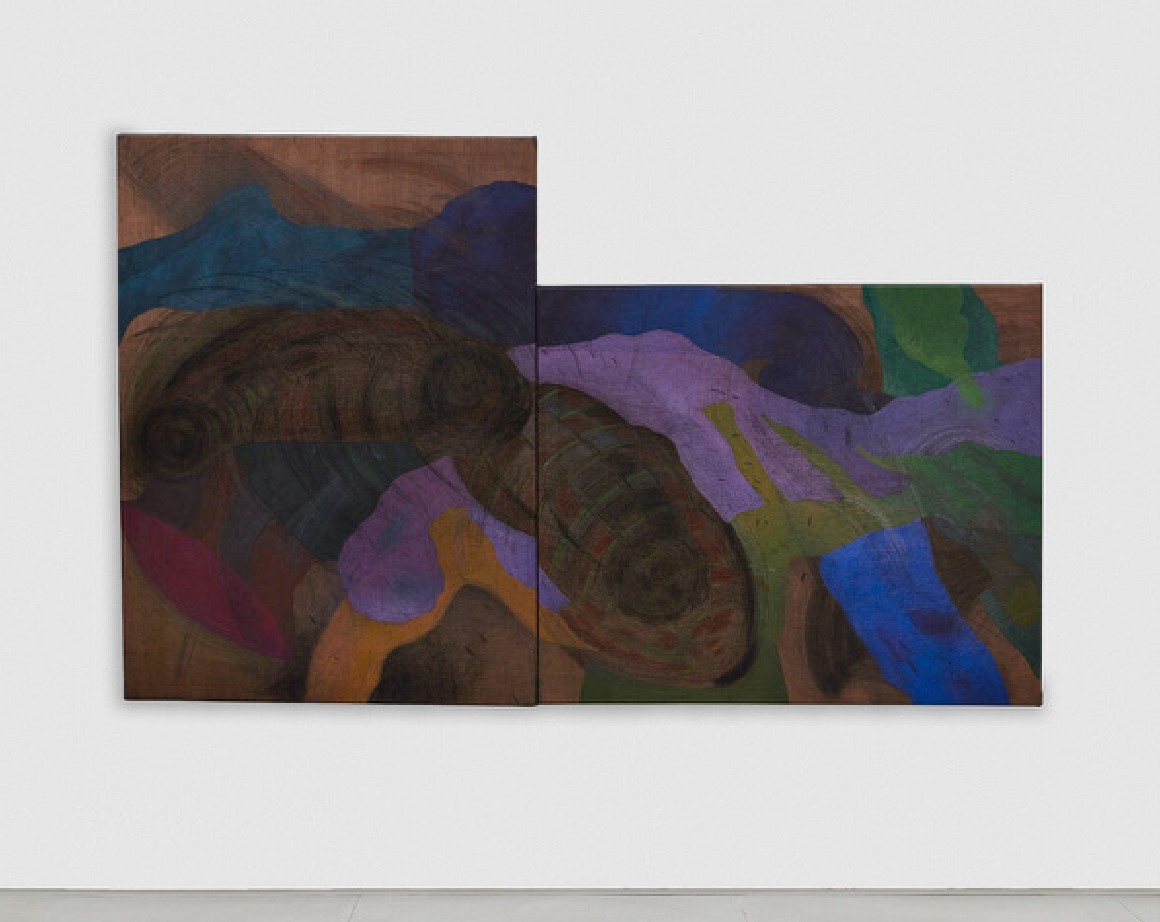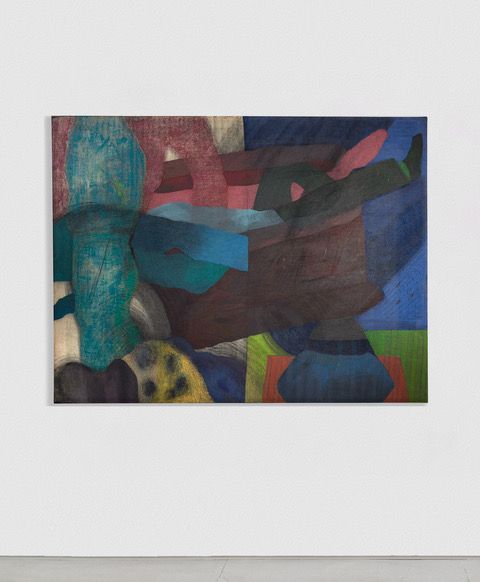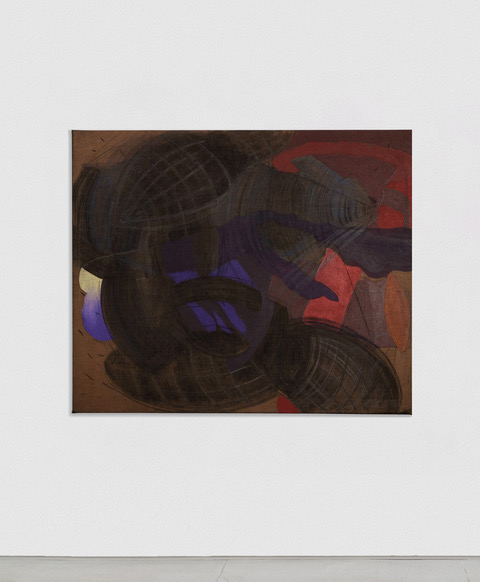
Songs of Silence, yet Bluebirds Hum, opened on September 9th (and will run until November 4th) at Patron Gallery in Chicago, Illinois. Viewed by the artist, Kaveri Raina, as a continuation of the body of work featured in her previous show, Image as a Burden, Death as a Womb (2022) at Chapter Gallery in New York City, these new paintings and drawings draw inspiration from women throughout history.
Raina, who graduated from the School of the Art Institute of Chicago with her MFA, initially utilised painting as a way to navigate her hybrid identity and her existence between two cultures. Born in New Delhi, India, her paintings until 2021 deliberately focused on the personal, referencing events in her youth like memorable moments with her sister or being taught to cook by her mother. Raina came across Rani Lakshmibai, who became a leading figure in the Indian Rebellion of 1857 after the death of her husband, the Raja of Jhansi.
While the artist states that this series is a departure from previous work that was firmly rooted in her personal history, the work, simply by engaging in conversation with female figures and Indian history, is still an exploration of self. Through the stories of Lakshmibai and Jyoti Singh, Raina continues to weave a thread to the past, a past that extends far beyond her own. She has replaced the vivid oranges, reds, and greens through the use of turmeric, red powder, and fennel seeds that were central to previous work with rich shades of brown, purple, and blue. “I’m not picking the colours that are pleasant to me. I’m trying to channel this other side where I’m trying to find gritty, grimness, somberness, or heaviness,” she says. The work bridges the histories of violence perpetrated against women, managing a balance between the mournful essence of the colours used and what the artist has identified as hope. Despite the emotional heaviness of her paintings and the dark marks of her drawings, the pieces in the exhibition foreground a sense of renewal that can develop after tragedy. “I feel these paintings are quieter. They’re more sombre as an aftermath,” she says.
Speaking about her painting process, the artist shares that she works on only one painting at a time, never wanting to split her focus between several pieces. Each piece takes at least a month, and as she’s working on a painting, it hangs on one wall of her studio, while the opposing side is where she finds herself thinking about and looking at the piece. She refers to this as being in conversation with the painting and its subjects. For this series, as she worked and sat with each piece, she found herself conversing with Lakshimibai and Jyoti Singh, whose gruesome story was introduced to her via the television show Delhi Crime Story, which a friend had recommended to her. Like Lakshmibai, Singh was robbed of her life at the hands of men who held power.

Taking note of Gustave Courbet’s A Burial at Ornans (1849-50), the concept of aftermath is explored throughout the exhibition. Though the funeral depicted in the painting is situated in the middle of the frame, it is not the central focus. Instead, it is the coming together for the ceremony to say farewell to the individual who has passed. Raina shares that while listening to a podcast with Rashid Johnson, an artist whose work she admires, she learned of how he demands his audience to be witnesses to his work, unable to move past. There’s an action they have to remember, thereby becoming a part of their memory. It is the living who are serving as witnesses. She asks, “What does it mean when you’re gathered around? Whether it’s remembering them in a nice way or remembering them in another way, it’s a memorial of sorts.” It is this same act that she anticipates will be repeated when the exhibition is viewed, for these paintings to be one-on-one experiences and sites of remembrance of individuals who have departed from the lives of viewers.
Though the new body of work grew out of Raina’s interactions with the stories of Lakshmibai & Jyoti Singh, the artist recognises and encourages viewers to see someone they know in her paintings. The artist took inspiration from fellow School of Art Institute of Chicago graduate, artist Leon Golub, whose paintings feature figures that feel as if they’re hovering over you. In her paintings, immense bodies extend past the boundaries of the frame, mirroring the authoritarian figures that stand at the top of hierarchical structures in society. The size of the paintings, like …and still raging, treading through the desolate silence (2023), which measures 68” x 110”, make it difficult to turn away, forcing viewers to reckon with the images in front of them and participate in the farewell to the deceased.
While the artist states that this series is a departure from previous work that was firmly rooted in her personal history, by being in conversation with these female figures and engaging with and rooting the pieces in Indian history, it is still an exploration of the self.
In speaking about the preparation of the burlap, Raina states that she does not prime it as doing so would close the pores of the surface, hindering the ability of the paint to soak through to the front. “I have stretched it on a wooden panel before, but I didn’t like it. So it’s always unprimed. There’s no sealant applied to it.” That she chooses to leave the burlap in its raw state, with the coarse texture a crucial element of her work, is not only a nod to the nostalgia felt by the artist as she would encounter burlap or the jute it is made from growing up in India but can also be viewed as analogous to the officials in charge, with the primer being the protection they are meant to provide. The dry mediums the artist utilises permeate through the space, clinging to all surrounding surfaces.
She goes on to say that the lack of primer will sometimes cause the burlap to sag, moulding itself to the shape of the material placed on its surface, much like coffee beans in a burlap sack. She is able to work from the back, with the paint bleeding through to the other side. As she moves between the front and the back, the changing form of the burlap mimics movement similar to the gestural marks placed on it by Raina. These marks can be viewed as a reflection of the artist’s internal emotional response to the stories, experiences, and figures from which the pieces developed.

In the exhibition, the artist extends these feelings of fury beyond her paintings to a drawing installation, the first time she’ll have a dedicated space for her drawings. She shares that it is much more immersive than previous exhibitions. The installation, which will be set up in the back room, will include panels that create a maze, necessitating a negotiation with each piece. She says that with drawings, working on a piece of paper on a table aids in the emergence of aggression and crudeness not possible with the soft surface of burlap. It also produces a loudness, an echo of the voices of women.
Raina recognises the need for quietude, particularly when working with subject matters that can corrode whoever is in the viewing position. “There are moments of quiet because I’m just sitting there and trying to figure it out. That’s productivity for me. It’s not always making, actually creating. So thinking, staring, writing, listening to something, whether it’s a podcast or a piece of music, is all part of creating.”
To be able to reflect and sit in silence is a freedom that was not afforded to Lakshmibai or Joyti Singh, further emphasising the political within Raina’s work. They themselves were silenced, and through these paintings, there’s an attempt to reclaim these voices, not just of these two women but of women worldwide. The work compels viewers to bear witness to the rage, despair, and forced victimisation that emanates from violence. As Kapil asks, “What does it mean to be silent?”
Words by Karla Méndez





